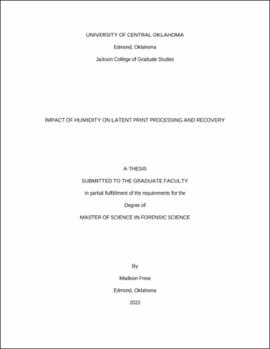| dc.contributor.advisor | Mabry, John P. | |
| dc.contributor.author | Frese, Madison | |
| dc.date.accessioned | 2023-09-07T19:15:09Z | |
| dc.date.available | 2023-09-07T19:15:09Z | |
| dc.date.issued | 2023 | |
| dc.identifier.other | (AlmaMMSId)9982969811502196 | |
| dc.identifier.uri | https://hdl.handle.net/11244/339447 | |
| dc.description.abstract | The goal of this study was to determine if environmental factors impact the quality of detail in latent prints on non-porous and porous surfaces. Specifically, this study focused on how humidity impacts latent print processing, development, and analysis on tile and paper. Latent prints are prints deposited on surfaces in sweat (James, Nordby & Bell, 2014). As humidity is water vapor in the air, it is expected that increased humidity would have a noticeable impact on the quality of latent prints. To date, no research has been conducted comparing how humidity impacts latent prints on porous and non-porous surfaces at consistent temperatures. In this study, latent prints were deposited on a non-porous surface (white tile) and a porous surface (paper) and subjected to 30%, 50% and 90% humidity at a consistent temperature range (70-74 degrees Fahrenheit) to assess if humidity causes a noticeable change in the quality of latent prints. Once collected, prints were uploaded into the Automated Fingerprint Identification System (AFIS), which was set to automatically mark minutiae. Minutiae were then edited by an experienced latent fingerprint examiner to ensure accuracy. The edited minutiae count generated from AFIS was used to determine what category each print fell under: low quality (0-6 minutiae), moderate quality (7-12 minutiae), or high quality (13 and above minutiae). Multiple statistical tests were performed to determine statistical significance between different variables. This included comparing tracked humidities, tracked temperature ranges, overall minutiae count between humidities, and change in minutiae count over time. Based on the results, humidity did appear to have an impact on the quality of the prints over time for both surfaces, porous and non-porous. Overall, quality decreased with increased levels of humidity. At each humidity, a decrease in quality was also observed over time. The only prints that deviated from this were the prints on the tile at 90% humidity tile. These prints stayed at a consistent low quality. This leads to the conclusion that prints recovered on white tile with black powder and prints recovered on paper with ninhydrin decrease in quality with increased levels of humidity and also decrease over time at set humidities. | en_US |
| dc.rights | All rights reserved by the author, who has granted UCO Chambers Library the non-exclusive right to share this material in its online repositories. Contact UCO Chambers Library's Digital Initiatives Working Group at diwg@uco.edu for the permission policy on the use, reproduction or distribution of this material. | |
| dc.subject.lcsh | Fingerprints--Identification | |
| dc.subject.lcsh | Humidity | |
| dc.title | Impact of humidity on latent print processing and recovery | en_US |
| dc.type | Academic theses | |
| dc.contributor.committeeMember | Porterfield, Caitlin | |
| dc.contributor.committeeMember | Casper, Katie | |
| dc.thesis.degree | M.S., Forensic Science | |
| dc.subject.keywords | Black powder | |
| dc.subject.keywords | Fingerprint analysis | |
| dc.subject.keywords | Forensic science | |
| dc.subject.keywords | Humidity | |
| dc.subject.keywords | Ninhydrin | |
| dc.subject.keywords | Quality | |
| dc.subject.keywords | Automated Fingerprint Identification System | |
| dc.subject.keywords | Criminology | |
| dc.subject.keywords | Analytical chemistry | |
| dc.identifier.oclc | (OCoLC)1396571454 | |
| thesis.degree.grantor | Jackson College of Graduate Studies | |
